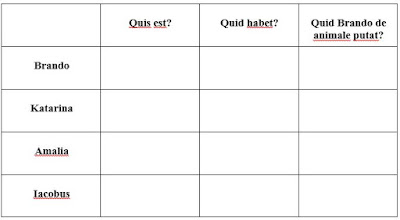Bob Patrick and I have begun teaching Brando Brown Canem Vult in our Latin 1 classes at Parkview. As I have never taught a CI novella before, this is all new to me. I am definitely learning a lot in the process!
In my Latin CI journey over the past few years, one of the biggest concepts which I have learned is the difference between reading and translating/decoding. When I was learning Latin in high school and in my college/graduate level Latin courses, "reading" consisted solely of decoding large portions of classical texts, which were written at a VERY high level of Latin. In order for me to translate the text, it was necessary for me to have a Latin dictionary, a grammar primer of some kind, and an English translation of the text in order for me to check if I had gotten it correct. To me, that was reading, when in reality it was very tedious decoding. I was not doing any reading at all, because the language structures and vocabulary were beyond my knowledge, so I had to rely 100% on a dictionary, grammar books, and an actual translation to establish meaning. Due to my experiences at Rusticatio and in teaching CI, I have learned that reading and translating are two completely different skills and that it is possible to read Latin as Latin! I had never experienced that before in my college and graduate classes, as we focused purely on translation/decoding.
In order to ensure that something is readable, one must be familiar with 90% of the words in the text. When a large portion of words are unknown to the reader, frustration ensues, and one's affective filter rises. Readers will give up if a reading is incomprehensible. So many times when we see students give up on a reading, we blame the student and label him/her as "lazy" - have we ever thought that this is actually a normal reaction to a text which he/she finds incomprehensible?
Because I wanted students to start reading Brando Brown Canem Vult this semester, it required me to be 100% deliberate in what vocabulary I taught leading up to it. At the very beginning of the semester, using an online word count tool, I entered in the first chapter of BBCV (a downloadable PDF of the first chapter exists on the TPRS Publishing website) in order to determine word frequency (at this time, a Latin teacher's edition does not exist, but I am assuming that the TE will have something like this when it comes out). This is what I found:
This list became my guide as to what vocabulary words I was going to preteach for the semester so that students could read the first chapter. For 11 weeks, my goal was for students to acquire at least 50 of the words (a number of the words on the list are cognates or only appear once in the chapter so those words could be glossed) through various stories and activities so that by the 12th week, the first chapter would be quite comprehensible for students. During these 12 weeks, Bob and I also taught more words than just these, as we also did a cultural reading on Roman houses vs. insulae, and we did a reading on the creation myth. My goal, however, was always to begin Brando Brown Canem Vult by mid-end of October.
When it came time to introduce the first chapter, I was quite nervous if students would find the reading difficult. Just because I had pretaught most of the vocabulary did not necessarily mean that it would transfer to student ease in reading the novella. For the first day of reading, I simply handed the books to students and had them follow along as I read the first chapter aloud to them. When I was done, I asked them what they thought. The majority of students said, "That was actually pretty easy." I took that with a grain of salt, though, because in my mind I kept thinking, "Just because students say that it was easy does not mean that they totally understood what they read." On the following day, I did some post-reading activities (of which one was a Kahoot game completely in Latin based on the 1st chapter), and I was blown away by how students responded in the target language. Yes, the majority of students truly understood what they had read! The fact that they knew most of the vocabulary words in the first chapter had to mean something in terms of their comprehension! A few students even commented to me, "Now I understand why you had use learn words like molestus and ingeniosus."
Next post: the Brando Brown Canem Vult 1st Chapter Lesson Plan

